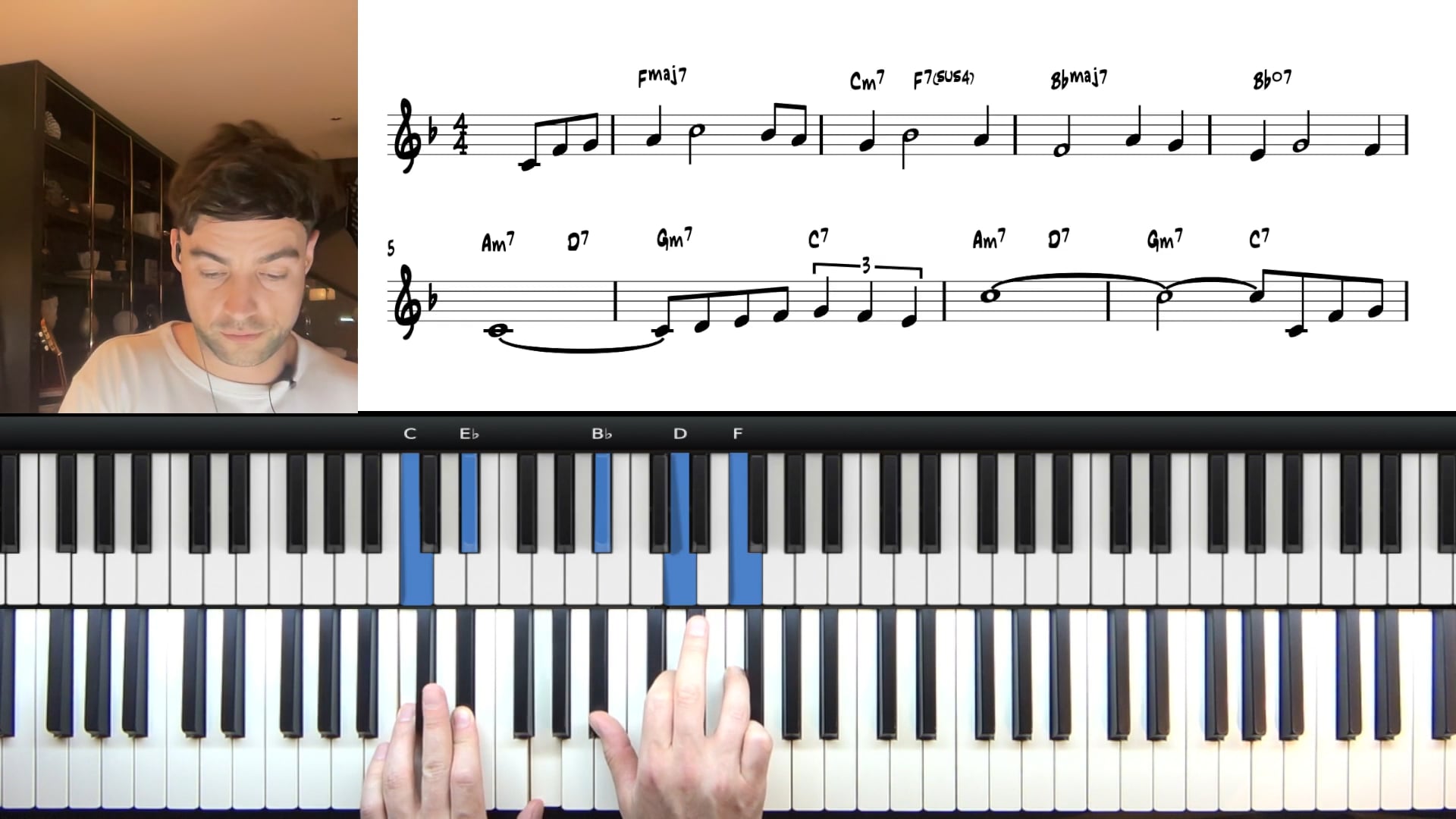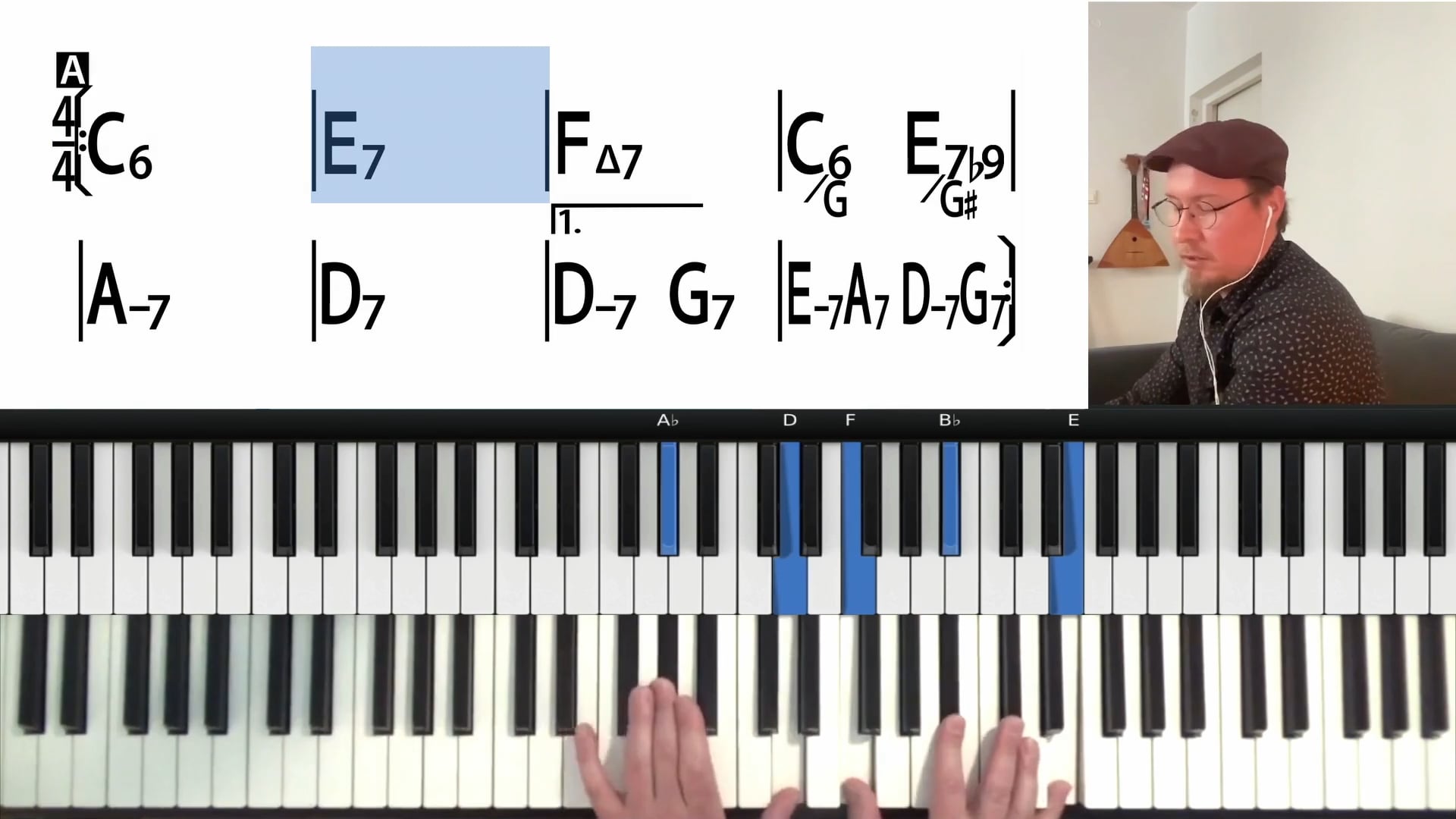
Tuomo Uusitalo
Tuomo is an award-winning pianist, composer, arranger and educator. Having released two albums as a leader, he has established himself in the New York jazz scene and continues touring internationally both as a leader as well as sideman.
Live Seminar Resources
Live Seminar Resources
PDF Downloads
- Session 3 Handout & Homework
Join PianoGroove Pro to access all downloads and learning resources.
Download theory supplements, midi files, chord changes and full note-for-note transcriptions of every lesson.
- Bye Bye Blackbrid
Join PianoGroove Pro to access all downloads and learning resources.
Download theory supplements, midi files, chord changes and full note-for-note transcriptions of every lesson.
- 3 Blues Licks Notation
Join PianoGroove Pro to access all downloads and learning resources.
Download theory supplements, midi files, chord changes and full note-for-note transcriptions of every lesson.
- Blues In F - Form
Join PianoGroove Pro to access all downloads and learning resources.
Download theory supplements, midi files, chord changes and full note-for-note transcriptions of every lesson.
- Ascension Transcription
Join PianoGroove Pro to access all downloads and learning resources.
Download theory supplements, midi files, chord changes and full note-for-note transcriptions of every lesson.
- Jazz Blues Backing Track
Join PianoGroove Pro to access all downloads and learning resources.
Download theory supplements, midi files, chord changes and full note-for-note transcriptions of every lesson.
Forum Threads
Seminar Description
Seminar Description
Jazz Language & Melodic Improvisation
Welcome to the third and final seminar in our beginner-focused series on jazz improvisation. In this final instalment, we explore advanced practice strategies for learning and internalising jazz language.
This lesson centres around the idea that improvisation, much like spoken language, is built upon vocabulary and structure. The focus is on collecting, transposing, and applying melodic phrases from jazz recordings and transcriptions.
Improvisation as Musical Language
Improvisation in jazz should not be thought of as spontaneous note generation, but rather as the reorganisation and reinterpretation of musical vocabulary we’ve absorbed. Like learning a new language, it’s essential to start with “words” — short melodic ideas and motifs — and then string them together to form coherent “sentences.” These melodic ideas come from transcriptions of recordings by jazz masters, forming the building blocks of your own improvisational voice.
Thinking in Melodies, Not Scales
Instead of using scales as the primary framework for improvisation, students are encouraged to think in terms of chord tones and guide tones. Focusing on melodic content derived from chord tones leads to more musical and harmonically grounded solos. When working over 2-5-1 progressions, such as D-7 to G7 to Cmaj7, identifying and targeting the 3rds and 7ths of each chord gives direction and purpose to your lines.
Transcribing and Applying Jazz Language
A major component of this seminar is the transcription and application of existing jazz vocabulary. Students are encouraged to take short melodies from recorded solos, analyse how they relate to the underlying chord changes, and then transpose them to all 12 keys. This is best done using 2-5-1 progressions in multiple contexts, including the blues form and standard tunes.
The instructor uses a sample melody over a 2-5-1 in C major to demonstrate this process. The melody is broken down into parts, then analysed in relation to the chord (starting on the 7th of D-7, moving through the 9th and 11th), and finally transposed into other keys such as F major and Bb major.
Applying Melodies to the Blues in F
Once comfortable with a transcribed melody, the next step is to embed it into a familiar form such as the blues. The lesson highlights how to spot 2-5 progressions within a 12-bar blues in F and insert the learned melodic material at appropriate moments, such as in bars 4 (C-7 to F7) and 10 (G-7 to C7). Even dominant chords like Bb7 or F7 can be treated as parts of 2-5s, providing more opportunities to utilise learned vocabulary.
Using Transcriptions Creatively
The lesson concludes with a creative challenge: compose a full solo over a blues in F using only transcribed melodies from the seminar material or referenced solos (such as those by Red Garland, Hank Jones, or Wynton Kelly). Students are encouraged to notate the solo, analyse each line, and experiment with recombining different fragments to find what sounds best. This compositional approach to improvisation builds strong foundations for real-time soloing.
5 Practice Tips
-
Transcribe Short Phrases – Start with a simple 2-bar phrase from a great solo and learn it thoroughly before moving on.
-
Transpose to All Keys – Take each phrase and practice it over 2-5-1 progressions in all 12 keys to internalise the melodic contour.
-
Think in Chord Tones – Always relate notes to the chord tones (Root, 3rd, 5th, 7th) instead of scale degrees to better target harmonic resolution.
-
Use the Language Over Blues – Find places within a blues form where your transcribed material fits naturally.
- Combine and Recompose – Mix elements from different transcriptions to build longer lines and create your own melodic identity.
By consistently applying these techniques and focusing on melodic learning, your improvisation will evolve from random noodling to purposeful and idiomatic jazz phrasing.
This seminar encourages patience, repetition, and creativity — essential traits for any aspiring jazz pianist.








Excellent lesson – thank you.